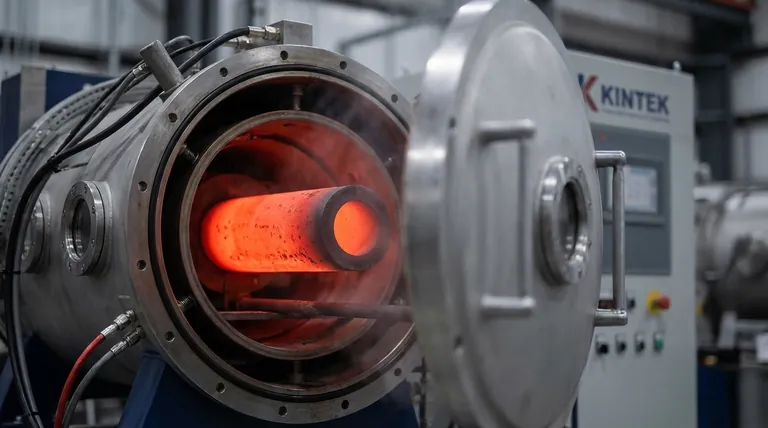네, 흑연은 고온 응용 분야에 탁월한 재료입니다. 하지만 그 성능은 주변 분위기에 따라 크게 달라집니다. 불활성 또는 진공 환경에서는 대부분의 금속의 녹는점을 훨씬 초과하는 온도에서도 구조적 무결성을 유지합니다. 그러나 산소가 있는 환경에서는 그 기능이 심각하게 제한됩니다.
핵심은 흑연이 극한 온도에서 가치를 발휘하는 것은 독특한 특성들의 조합 때문이라는 것입니다. 온도가 높아질수록 강해지고 탁월한 열충격 저항성을 가집니다. 그러나 주요 한계는 산화에 취약하다는 점이며, 이는 성공적인 사용을 위한 가장 중요한 요소가 됩니다.
흑연이 극한 온도에서 탁월한 이유
흑연의 고온에서의 거동은 종종 직관에 어긋납니다. 가열되면 연화되고 약해지는 금속과는 달리, 흑연의 성능은 향상되어 가장 까다로운 열 환경을 위한 최고의 재료가 됩니다.
열에 따른 강도 증가
흑연은 희귀하고 매우 가치 있는 특성을 나타냅니다. 인장 강도가 온도에 따라 증가하며, 약 2500°C (4532°F)에서 최고조에 달합니다. 이 지점에서 실온보다 두 배 더 강할 수 있습니다.
이는 내화 금속이 실패할 수 있는 하중에서도 구조적 무결성을 유지할 수 있게 합니다.
탁월한 열충격 저항성
이 재료는 매우 높은 열전도율과 낮은 열팽창률을 결합하고 있습니다. 이러한 조합은 탁월한 열충격 저항성의 핵심입니다.
균열이나 파손 없이 매우 빠르게 가열하고 냉각할 수 있습니다. 참고 자료에서 언급했듯이, 이 특성은 산업 공정에서 공정 주기 시간을 크게 단축시키므로 매우 중요합니다.
대부분의 금속을 넘어서는 승화점
흑연은 대기압에서 녹지 않습니다. 대신, 약 3650°C (6602°F)의 극도로 높은 온도에서 승화하여 고체에서 기체로 직접 변합니다.
이는 텅스텐이나 몰리브덴과 같은 고성능 금속보다 훨씬 넓은 사용 가능 온도 범위를 제공합니다.

결정적인 요소: 분위기와 산화
고온에서 흑연의 가장 큰 약점은 산소와의 반응입니다. 이것은 사소한 세부 사항이 아닙니다. 이는 흑연 사용을 결정하는 핵심적인 트레이드오프입니다.
산소 문제
개방된 공기와 같은 산소가 풍부한 환경에서 흑연은 500°C (932°F)만큼 낮은 온도에서도 산화(사실상 연소)하기 시작합니다.
이 반응은 CO 또는 CO2 가스를 형성하여 재료가 질량을 잃고, 열화되며, 궁극적으로 파손되게 합니다. 이로 인해 보호되지 않은 흑연은 공기 중에서 고온 사용에 부적합합니다.
불활성 환경에서 번성
흑연의 잠재력을 최대한 발휘하려면 진공 또는 아르곤이나 질소와 같은 불활성 가스 분위기에서 사용해야 합니다.
이러한 제어된 환경에서는 산화가 방지되며, 흑연은 최대 3000°C에 가까운 온도까지 안전하게 사용할 수 있습니다. 이것이 흑연이 진공로 부품의 지배적인 재료인 이유입니다.
보호 코팅 및 재료 등급
일부 산소 노출이 있는 응용 분야의 경우, 흑연 표면을 밀봉하기 위해 특수 산화 방지 코팅(예: 탄화규소)을 적용할 수 있습니다.
또한, 올바른 흑연 등급을 선택하는 것이 중요합니다. 고밀도, 고순도 등방성 또는 압출 등급은 고온 구조 성능을 위해 특별히 설계되었습니다.
응용 분야에 맞는 올바른 선택
흑연 사용 결정은 전적으로 특정 작동 조건에 달려 있습니다.
- 주요 초점이 500°C 이상의 개방 공기 환경인 경우: 표준 흑연은 부적합합니다. 특수 보호 코팅 또는 세라믹이나 내화 금속과 같은 다른 재료를 고려해야 합니다.
- 주요 초점이 진공 또는 불활성 가스 용광로인 경우: 흑연은 사용 가능한 최고의 비용 효율적인 재료 중 하나이며, 극한 온도에서 우수한 강도와 안정성을 제공합니다.
- 주요 초점이 빠른 열 순환인 경우: 흑연의 뛰어난 열충격 저항성은 이상적인 후보이며, 주기 시간을 단축하고 장비 수명을 늘릴 수 있습니다.
흑연의 엄청난 열 강도와 환경적 취약성 사이의 상호 작용을 이해하는 것이 흑연을 효과적으로 활용하는 핵심입니다.
요약표:
| 특성 | 고온에서의 거동 | 주요 이점 |
|---|---|---|
| 강도 | ~2500°C까지 증가 | 극한 하중에서도 무결성 유지 |
| 열충격 저항성 | 높은 전도성 및 낮은 팽창으로 탁월 | 균열 없이 빠른 가열/냉각 가능 |
| 녹는점 | ~3650°C에서 승화 | 대부분의 금속을 훨씬 능가하는 사용 가능 범위 |
| 산화 저항성 | 500°C 이상 공기 중에서 불량; 불활성/진공에서 탁월 | 분위기가 성공의 결정적 요소 |
실험실에서 흑연의 고온 기능을 활용할 준비가 되셨습니까?
KINTEK은 진공 및 불활성 분위기 용광로용 흑연 부품을 포함하여 고성능 실험실 장비 및 소모품을 전문으로 합니다. 당사의 전문 지식은 우수한 열 안정성, 빠른 순환 및 오래 지속되는 성능을 위해 올바른 재료 등급 및 구성을 확보하도록 보장합니다.
지금 당사 전문가에게 문의하여 당사의 흑연 솔루션이 귀사의 고온 공정을 어떻게 향상시킬 수 있는지 논의하십시오!
시각적 가이드




















